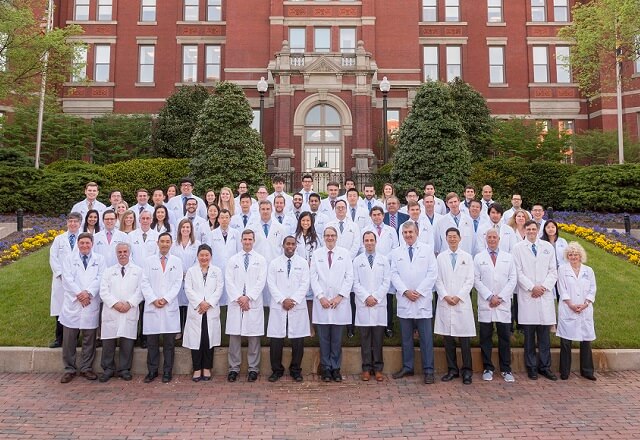Johns Hopkins Neurosurgery Residency Program Overview

PGY-I
The rotations of the surgical internship are designed to fill the needs of those planning for a neurosurgical career, and emphasize pre- and post-operative care, emergency care of the trauma victim, management of the surgical patient, intensive care and neuro-critical care medicine and the development of requisite surgical skills. We have recently added major rotations in the neurosciences.
This year of training is split between rotations in general surgery and in the neurosciences. The three-month rotations in the neurosciences include:
- Three months on the neurosurgery service
- Neurology in-patient service
- Neurology consultation service
- Neurological critical care unit
- Neuro-ophthalmology, neuropathology and neuroradiology
Rotations include general surgery, plastic surgery, thoracic surgery, cardiac surgery, vascular surgery, pediatric surgery and the surgical intensive care unit.
PGY-2 and PGY-3
The next two years of residency (PGY-2 and PGY-3) are spent at The Johns Hopkins Hospital. The rotations, approximately two months each, include the various adult neurosurgery services. The junior neurosurgery resident is responsible for the daily care of all hospitalized patients on his or her service, and has a substantial operative experience during this time.
In addition to rotations on the adult neurosurgical services, the PGY-2s spend one month on the neuroscience intensive care unit and one month managing all consults which includes a designated resident consult clinic.
The PGY-3s increase their autonomy throughout this year. Their time is spent on the neurosurgical adult and pediatric services, as well as one month rotating on radiosurgery, treating patients in our clinic and managing all consults.
PGY-4
PGY-4s spend six months at the Johns Hopkins Bayview Medical Center as a senior/chief resident. The time at Bayview allows a complete experience in patient care, beginning with outpatient programs and continuing to required hospitalizations, surgery and postoperative care. PGY-4s also rotate on our pediatric neurosurgery, endovascular, radiosurgery and consult services and are assigned apprenticeships, providing them with one-on-one faculty/resident training.
PGY-5 and PGY-6
These are two protected research years with opportunities for basic research, clinical research and clinical electives. There is an astounding level of scholarly productivity by residents accomplished in conjunction with the strong commitment of our faculty to laboratory and clinical research. Basic research opportunities are available in every Johns Hopkins department. Those interested in clinical research have established programs in the School of Public Health and joint training programs with the National Institutes of Health. Experience in laboratories and institutions other than Johns Hopkins may be arranged if appropriate. Our residents participate in laboratory research, outcomes based research and surgical enfolded fellowships.
Neurosurgery research residents have the opportunity to participate in our SNS and CAST-approved fellowships in the following subspecialties: neurocritical care, cerebrovascular neurosurgery, spinal neurosurgery, neurosurgical oncology, peripheral nerve neurosurgery, stereotactic and functional neurosurgery and pediatrics.
PGY-7
The final year of the program is the chief resident year. The Chief Residents practice under the supervision of the faculty and are responsible for all aspects of patient clinical care on the three adult neurosurgery services, (Dandy, Cushing and Brem). Since the operative volume is large, the surgical experience is extensive. Another important component to this year is the outpatient clinic experience maintained by each chief resident under the supervision of the faculty .
Our program is fully compliant with the ACGME recommendations regarding resident on-call hours.
Hear from Our Residents and Faculty Members
Learn more about the Johns Hopkins Neurosurgery Program from current residents and faculty members, as well as hear what it’s like living and working in Baltimore.
Learn more about our current residents
